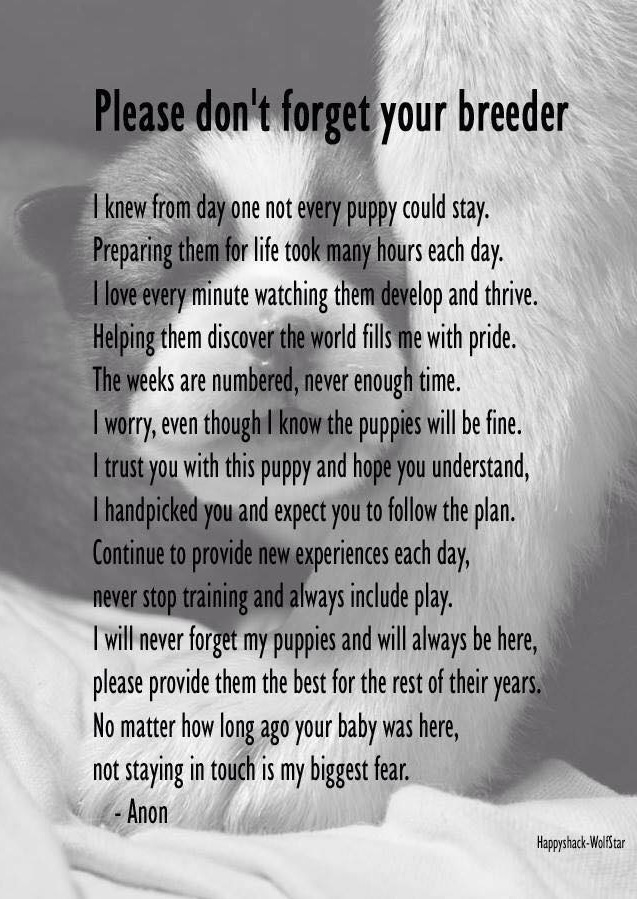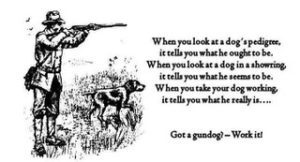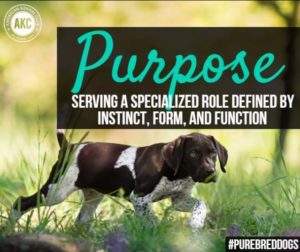There are many, many books on training spaniels for the field and I recommend they be consulted. I am not a “trainer” tho I do train my own dogs. I do seek help from a pro if I’m not able to train or fix a certain behavior. I raise my puppies with their future in the field in mind and try to set a foundation for what they will be doing on the hunt.
First Things First….
To start, it’s important to remember that puppies’ minds, like human babies, are little sponges. They will absorb everything, the good and the bad! The most inquisitive, the constant sniffers, the ones that can’t wait to get out of the nest and start exploring are the ones who usually are both the easiest and the hardest to train….easiest because they are bold, enthusiastic and quick to catch on to new lessons and learn and hardest because they will also learn your mistakes! It’s super important to make all things you want them to do as adults clear while they are puppies. For instance, NEVER discourage the pup from bringing you anything, even if it’s something disgusting, even if they stole it off the table or out of the garbage. Praise, thank them as you command they release it (“give”, or whatever you choose to say), put it back and remind to “leave it” if you want it left alone. Correct with “no, Leave It” if they try to pick it up again, or put it out of their reach. The correction is to not touch something specific or from a specific location (garbage, counter, etc), not for bringing it to you. It’s important to make that distinction.
Birdy Games
When I whelp a litter I introduce them to the smell of birds by letting them lay around with and later play with a pheasant wing in the whelping box (Never, EVER leave a wing out where the bitch can get ahold of it and chew it up! The dried bones are dangerous) I do this for a few minutes every few days while the bitch is out on a potty break so she does not interfere. This is to accustom them to the smell and feel of birds and feathers. When they are old enough to toddle around and see, around 3-4 weeks, I hang a wing with an elastic band (and string if necessary) from the top of the puppy pen so it’s hanging at eye level for the puppies…they will grab it, pull it, let go and it will “fly” away. They love this game! Again, NEVER allow this unsupervised! All these games involving dried wings and live or dead birds MUST be under supervision.
When they’re about 5-7 weeks old I let them play with the wing and also will introduce them to a dead or clipped wing pigeon if I have one. Quail are ok but they have a very loose feather that some dogs don’t like in their mouths and chukar and pheasant are too aggressive. I will let them chase down and mouth the pigeon (it is never injured….the puppies don’t have the ability to injure it.) and observe who the most assertive and highly driven are. I repeat this a few times a week with the pups as a group and also individually. Some pups are confident in a group only, important to note. Lacking a bird, I will tie a string to a pheasant wing (any game bird wing will do for this) and drag it in front of them to pique their drive, letting them “catch” the wing occasionally and letting the “winner” take off with it so I can observe. Some will bring it to you on their own by 7 weeks but mostly they are too intent on keeping it away from their littermates. I will also carefully observe who retains interest and keeps sniffing around when the bird or wing is removed. I will also lay a short trail for them to follow by dragging the bird along the ground and leaving it at the end of the trail (around a corner, out of sight) for them to find. This trailing game can be continued indefinitely, and made more challenging as the pup matures.
Around 8 weeks I toss the wing into the group and let them play keep-away with it, and if I can, I’ll get the “winner” to bring the wing to me in exchange for high praise and maybe a treat. I do the same with them individually. I let them play this game daily if I can, but even a few times a week is good, and I will also let them chase and retrieve a clipped wing pigeon if possible. At 8-10 weeks it’s a difficult task for such a small pup to retrieve a pigeon, so it’s especially noteworthy if a pup is keen to catch the bird and proudly bring it back to you without too much coaxing, even if they have to drag it by a wing tip.
I place puppies at 10 weeks. The one(s) I retain I continue with retrieve games with the wing, puppy dummies, soft toys and tennis balls. When they start teething I stop these games to avoid them experiencing any unpleasantness while their gums are sensitive. Soft toys are ok if the pup is not showing inclination to discomfort or chewing on the toys. I’ve had a few that went thru teething without a hitch and even continued to do retrieve work with no ill effect, but generally I avoid it as a precaution.
More Than Just Birds
As soon as they are old enough to toddle around I also start introducing them to various surfaces—grass, crushed stone, wire, plastic, concrete, etc. I provide a sonal tube to play in and roll around so they are not uncomfortable with wobbly footing and things that move. I also have a mini-seesaw that only rises an inch or two, a wobble board, and a chute tunnel minus the chute. In warmer weather I provide a kiddy pool for them to wade around it (Not so deep they can’t stand in it!) Always supervise when they are playing in the kiddy pool! Wherever they play I try to provide a lot of things they can climb on and hide behind. Around 6 or 7 weeks I also start allowing them to follow me a short way into the woods (even in shallow snow on a mild day) so they could start experiencing and investigating natural smells and cover. These outings get longer and more challenging as the pups mature.
Making a Partner
I teach the HUP command and the whistle as soon as possible. I also require my pups, as soon as they show a mastering of some self-control with the HUP command, to HUP for their dinner and not go to their bowl until they hear their name. My current pup (now adult) was voluntarily hupping for dinner and waiting for her name at 14 weeks when she observed the other dogs in the house doing it! I have had as many as 7 dogs lined up waiting for their name at dinner time (I have never fed adult dogs in their crates unless they were ill or in heat) This is in preparation for field protocol when dogs are sent on the retrieve at the sound of their name. Contrary to traditional obedience, field commands are never preceded by the dog’s name because their name is the equivalent of “OK, GO!”. Instead of “Rover, FETCH”, the command will be “FETCH…..ROVER!” . It gets tricky when training for traditional obedience as well as field commands. They do eventually learn context. It helps when you isolate certain toys/tools (eg., dummies, whistle) to only field activities.
The HUP command, a reliable recall to command and whistle and a reliable retrieve are your three most important commands in the field. The sooner you instill these lessons, the better. Out of the whelping box I start as soon as they can toddle, and simply never give the pup the option to not obey when possible, ignoring failures and making a big deal out of successes. Lessons are incorporated in daily activities and in play. Refinement comes later.
With babies I just encourage them to follow me and use casual words like “here”, “come on, let’s go!” as we walk around. We also sometimes play games where my husband and I will call the pup back and forth between us. More formal commands like “COME” and “COME FRONT” can come later when they have a better ability to concentrate. I use the whistle casually in the house with both the “turn” toot-toot and the recall cue, either by mouth or with an actual whistle, to call dogs to me for treats. I learned by accident that this has the effect of teaching a perfect turn at the end of the cast right from the beginning before you even start to teach a quartering pattern. I also learned that, as blowing a spaniel whistle indoors is hard on the ears, the “silent” whistle is a great tool for training indoors or outdoors where the neighbors are close-by and might complain.
The recall and the retrieve are tied together, tho some dogs will not want to come to you with their prize, especially if it’s a bird, at first. All pups seem to go thru the phase of wanting to play keep-away during adolescence. Normally you can nip this in the bud by turning your back on the offender and ignoring them until they bring you the object. If not, then a sterner approach may be necessary.
As a side note, my first dog was awful about not wanting to bring me the ball when we played and would dance around willing me to chase her. She didn’t care if I ignored her and would take her prize and go lay down with it. I had read that if you can train for the behavior and give it a name, you can control it, so I “taught” her to play keep-away and chased her around saying “I’m gonna get it! I’m gonna get it!” and she’d run away with glee. After about 5 minutes I’d say, “OK, that’s enough. Come” and when she came and sat for me and I took the object from her mouth I offered her a treat. I got in the habit of playing this game before training and sometimes in the middle of it to make it more interesting for her and the problem disappeared.
A bit of advise regarding retrieve – Try to insist on to-hand delivery from the very beginning. Then you won’t have to “fix” a dog that drops the bird before you can take it from him.
Once the pup is past teething and has a reliable response to Hup, the recall and a solid retrieve we commence with putting all the pieces together.



